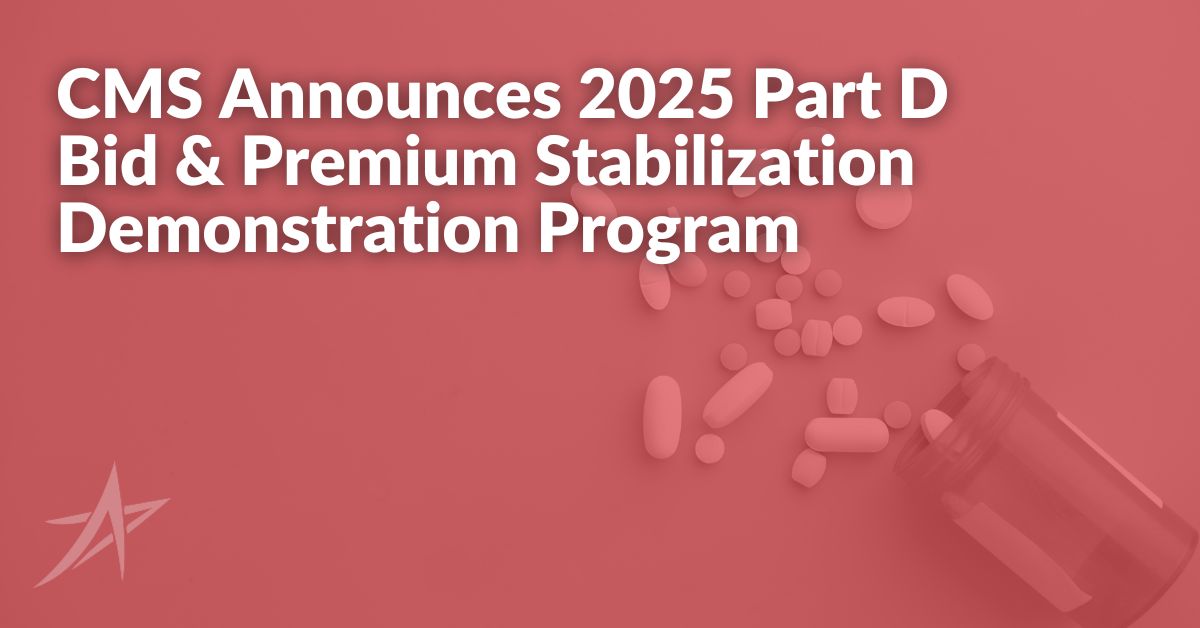
The Centers for Medicare & Medicaid Services (CMS) recently announced some exciting developments for Medicare Part D. On July 29, 2024, alongside preliminary 2025 Medicare Part D bid information, CMS introduced a new program designed to subsidize the cost of Part D as changes from the Inflation Reduction Act (IRA) take effect.
This voluntary Demonstration Project is expected to see participation from most Part D sponsors, which means Medicare beneficiaries likely won’t face the significant increases in stand-alone 2025 Part D premiums that were initially anticipated.
Here’s what you need to know for the 2025 Plan Year to help your clients better understand their coverage options and costs.
Overview of 2025 Part D Bids and Expected Changes
Many experts in the industry, including our own team, anticipated that IRA-related Part D changes, particularly the $2,000 out-of-pocket cap and the elimination of the coverage gap phase, would lead to substantial premium increases in stand-alone Part D plans for 2025.
According to CMS, the national average monthly bid amount (NAMBA) for 2025 prescription drug plans (PDPs) is $179.45, a significant increase of $115.17 compared to the 2024 NAMBA of $64.28. This suggests that stand-alone Part D premiums were set to rise significantly in 2025, despite receiving higher payments from the government due to changes in risk sharing. Furthermore, since all prescription drug bids (both PDP and MAPD) are included in the NAMBA calculation, and MAPDs generally had more competitive prescription drug bids, there was a weighting toward large premium increases for stand-alone Part D plans in the absence of the Demonstration Project.
To counteract potential market disruption and ensure consistent, lower-cost PDP options for beneficiaries, CMS has established a new Part D premium stabilization program.
CMS highlights that for 2025, “a significant portion of the NAMBA increase represents funds moving from reinsurance payments to upfront payments in the form of government subsidies to plans.”
The IRA also includes a provision limiting premium growth from 2024 to 2029 to six percent per year, resulting in about a $2 per year increase in monthly premiums for beneficiaries. However, this increase is the overall increase (both PDP and MAPD), and there was a notable difference between PDP and MAPD premium changes. With most premium increases impacting stand-alone Part D plans, CMS has introduced the new Part D premium stabilization program to prevent market disruption and maintain consistent and lower-cost PDP options for beneficiaries.
Understanding the Part D Premium Stabilization Demonstration Program
The CMS Part D Premium Stabilization Program is a voluntary three-year initiative where stand-alone Part D plan sponsors across the United States can receive subsidies to implement policy changes aimed at stabilizing premiums for beneficiaries.
The three main components of the program are:
- Reduced Premiums: Participating plans will reduce their base beneficiary premium by $15 for 2025, lowering the cost of their plan-specific premium. (If this causes the plan’s total premium to fall below $0, it will be set at $0.)
- Premium Increase Cap: Participating plans agree not to raise their plan-specific total premium by more than $35 in a calendar year.
- Government Risk Sharing: The government will assume more risk for potential losses among participating plans.
Plans may choose to opt out of the program in future years. However, plans that do not opt in by August 5, 2024, will not be allowed to join later.
Why MAPD Plans Are Not Included
Medicare Advantage Prescription Drug (MAPD) plans have more flexibility to offset premium increases through their larger benefit packages and access to additional rebates. As a result, CMS expects much less variation in MAPD premiums.
Impact on Part D Premiums for 2025
Participation in the new premium stabilization program should lead to smaller increases in stand-alone Part D plan premiums for 2025 than would have occurred otherwise. This is expected to reduce disruption and potential plan-switching in the PDP market.
CMS reports the preliminary estimated average government subsidy to plans as $142.67. This subsidy will help bring the 2025 base beneficiary premium to $36.78 — a $2.08 increase from the 2024 base beneficiary premium.
After the August 5th deadline for program opt-in passes, CMS will calculate preliminary average Part D premiums and finalize the premiums for individual plans in September.
The Future of Stand-Alone PDPs in 2025
Since we expect most, if not all, Part D sponsors to participate in the premium stabilization program, stand-alone Part D plans should remain a viable option for clients who prefer them over MAPDs.
The landscape of Part D is shifting as key changes from the Inflation Reduction Act are implemented. The 2025 premium stabilization program aims to keep stand-alone drug plan premiums at a more affordable level for clients in the coming years.
If you have any questions please contact our client support services at agents@taia.us . If you would like to read the full CMS Update click HERE.
